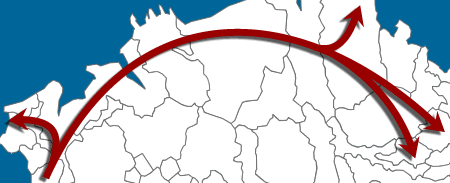Tassèrus and Teréðor
When the weary Vulmàryr first saw the beautiful forested slopes of Illyra there must have been weeks of celebration. In the 11th century LR, the area was populated by the Dwürden Fal of Ðirün, and so was probably well-lumbered and dotted with towns and villages for as far as the eye could see. The Dwürden however were expecting the Yrūn and had sat aside land upon the Illyri Peninsula that they figured would be plenty for any single race. It did not take long before the dismayed Dwürden realized that the peninsula would not contain their numbers.Circa 1000 – 1200 LR. Yrūnyr guests of the Vulmùri Dwürdènyr. The Sōphor take a southern route, crossing to Tassèrus, founding Shōphùroh. Yrūnyr flee Tūkùmun, scatter across the Dragul Marches. Na’Lir move south into the Ring of Sarràdir, oust the Ikítikírittìk. The Shir settle the Shar Cradle, emerging centuries later as the Anūhir and Naskar. The Nalékyr trek across norther Teréðor and settle the Gray Wastes.
Not all Yrūn that came to Vulmūra stayed there. The Sōphor were a religious caste who had emerged sometime before the coming of the Nāzar. Despite much intermarriage between the Nāzar and Vuldir, the Sōphor remained apart from the melding. When the Sōphor finally arrived at Vulmùra, their leaders looked with scorn upon the Dwürden lands and decided to lead their people southward. As they passed through fertile lands, many of their followers rebelled and settled along the coast of the Old Kingdoms. The rest of the Sōphor continued across the Southern Sea until they reached Tassèrus where they could settle upon the uninhabited shores of Shōphùroh (ca. 1150 LR).
When the people of Tūkùmun fled their failing Empire in the 34th century LR, they unknowingly continued in a direction set by their ancestors thousands of years before. Descendants of the Empire can today be found throughout the Dragul Marches.
In the Land of Teréðor, the Yrūn were a long way from home. For generations the Na’Lir had moved along the western shores of Teréðor, settling, moving, and settling again. Their numbers had recovered some from the slaughter received at the hands of the Eylfāe. Tales of Lyrast and the other Yrūni tribes passed into the substance of myth. After some time in the Abandoned Land of Juduð, a segment of the Na’Lir called the Kȳdir continued south (ca. 1100 LR) into the Ring of Saráddir. As they approached the Ringed Sea they found strange villages and cities rising along the shores of the sea. It can only be assumed that their Dwürden benefactors had warned the Yrūn about the region’s inhabitants, for otherwise the outcome is irreconcilable with what is known about the two peoples.It must be assumed that the Kȳdir were at least a bronze-aged people when they engaged the Ikítikírittìk for the stone age Lyràsti conflicts between these races had much different outcomes. The events that unfolded have been retold endlessly by Kirydi historians without any firsthand accounts of the ensuing war. These historians tell of the eradication of the Ikítikírittìk in a systematic campaign that saw the annihilation of their people and cities. The firsthand assistance of the Dwürden cannot be assumed, because it is not mentioned in Yrūni or Dwürdèni histories.
At the same time another branch of the Na’Lir, who are remembered as the Shir, moved across the coastal mountains and into the jungled interior of the Shar Cradle (ca. 1070 LR). Their numbers quickly dispersed into the resource heavy region and soon hundreds of tribes and nations appeared along the rivers and coasts of that land. Of all the destinations encountered during Yrūni migration, the Shar Cradle was the most hospitable. The only other Awakened races inhabiting the Shar at the time were scattered populations of Gnor, Ortor, Shūl, and Urdar. At the time, the Sha’al of Teréðor viewed the region with great distrust and refused to settle there.
After many generations, the Yrūnyr of the Shar began to spill into surrounding lands. The Mulk moved south into present-day Mulūk (bef. 1200 LR). The Naskar moved southeast into the plains of present-day Naskàra (bef. 1200 LR). The Anūhir moved east into the lands of present-day Panæð (bef. 1140 LR) with further splinters migrating east along the Thundering Isles and north into the Fertile Coast (bef. 1200 LR).
Perhaps the most remarkable story of the Fourth Migration was that of the Nalek, a minority of Na’Lir tribes who managed to retreat northward instead of being corralled down the Wild Coast by Eylfāe forces. The Nalek settled in the northwest corner of the continent for many years before making the near-impossible trek across the Frozen North of Teréðor. Over the course of a few hundred years (bet. 900-1200 LR), thousands made the journey across glaciers and lands where winter never relents. By some divine guidance the Nalek were led to the western reaches of the Gray Wastes where they settled in the lands of present-day Heréd Nor, Kiram, and Zar En’Kīar. These people have lived in relative isolation from the rest of the World for over 6,000 years. Their language and cultures are believed to most closely resemble that of the ancient Kȳrim.By the end of the Fourth Migration, the Yrūn lived upon every continent of the World of Teréth End. Subsequent migrations occurred for thousands of years, but mostly involved the shuffling of people within a given region.


